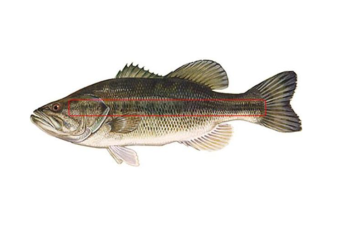 Welcome to part two of my two-part series on the senses of fish species. In part one, I gave you a little insight into the ways fish use their senses of sight and hearing to hunt and survive in harsh and demanding environments. Now, I'm here to finish the job and describe how vibrations, along with smells, impact fish and their behavior.
Welcome to part two of my two-part series on the senses of fish species. In part one, I gave you a little insight into the ways fish use their senses of sight and hearing to hunt and survive in harsh and demanding environments. Now, I'm here to finish the job and describe how vibrations, along with smells, impact fish and their behavior.
Along with a highly-tuned inner ear, fish also have an extremely receptive collection of tiny organs, known to most as the "lateral line," that runs along the sides of their body. This line is sensitive to sounds or vibration waves carried through the water from as far as 100 feet away. Furthermore, while sounds that occur out of the water, in the air, aren't detected by fish, vibrations caused by walking near the water's edge, or in a boat, will still transmit through the water and will be picked up by this lateral line. This is why fish are so easily spooked by movement, even when you don't think they can see you. On some species, such as snook or largemouth bass the lateral line is quite obvious, whereas on others, it isn't visible at all. Nevertheless, whether it's visible or not, all fish possess this collection of miniature organs and use it to pick up on subtle changes in underwater pressure, as well as sounds caused by any number of sources. This lateral line, compounded with a fish's already superb hearing, make an excellent combination for hunting and evading predators underwater.
Yes, there is a reason for the hundreds of scents on the market today: fish possess a very developed olfactory system, which, in fact, makes up a large part of their brain. Located above the mouth, towards the front of their head, this sense is a very important part of a fish's feeding habits. Now, while this sense is important to all fish, certain species rely on it more than others. Scavengers and bottom-feeders, like catfish and carp, use their nostrils to locate food and forage the mud and rocks that make up the bottom of a body of water. Predatory fish, such as pike and bass, however, will utilize their olfactory organs, of course, but will still rely more on their sight when hunting.
Most fish are able to detect odors from hundreds of yards away, and can even pick up a scent within the tiniest particle of water. Foreign odors, such as human scents, oils, gasoline–common scents produced on a fishing trip–will frighten fish and drive them away. This is why so many companies produce natural scent products that attract fish to your lure. Also, a good fish soap or even Fish Hands, a line of sanitizing wipes, will rid your hands of any foreign odors, thus reducing the risk of spooking the fish.
There you have it, my fellow anglers; the four main methods and senses utilized by fish to hunt, hide, and generally, survive in an underwater environment daily. Hopefully, despite the impressive qualities of the various senses of fish species, you've learned just how to appeal to these senses when fishing and implement the characteristics of different lures and baits on the water. Personally, learning this information over the years has helped me immensely and I'm so glad to be able to share it with you in these articles. I hope that the information I've outlined for you helps provide a better understanding of fish and how they react to any number of changes to their habitats and the water that surrounds them.








